Climate Primer
By Elise Haschke, NCAT Climate and Agriculture Program Manager; Lee Rinehart, NCAT Northeast Regional Director; and Darron Gaus, NCAT Sustainable Ag Specialist
Scientists agree: human-caused global warming is real, and it’s bad. Severe weather is impacting all regions of Earth and will continue to increase in intensity and frequency as warming continues. The climate crisis demands our attention and our collective action towards restoring balance with natural Earth ecosystems. Climate-beneficial farming practices are one of the many pathways to mitigate climate change, while simultaneously building resilient ecological systems that can help farmers and ranchers adapt to unpredictable and unprecedented climate disruptions.
It’s Real, and It’s Us
“It is unequivocal that human influence has warmed the atmosphere, ocean and land.” (Intergovernmental Panel on Climate Change, 2021).
- 97% of scientists agree: Human-caused climate change is happening (Shaftel, 2022).
- 72% of Americans believe global warming is happening (Marlon et al., 2022).
Thousands of peer-reviewed scientific papers have concluded that human activities emit heat-trapping greenhouse gases into the atmosphere (Shaftel, 2018). The primary greenhouse gases emitted into our atmosphere are carbon dioxide (CO2), methane (CH4), and nitrous oxide (N2O).
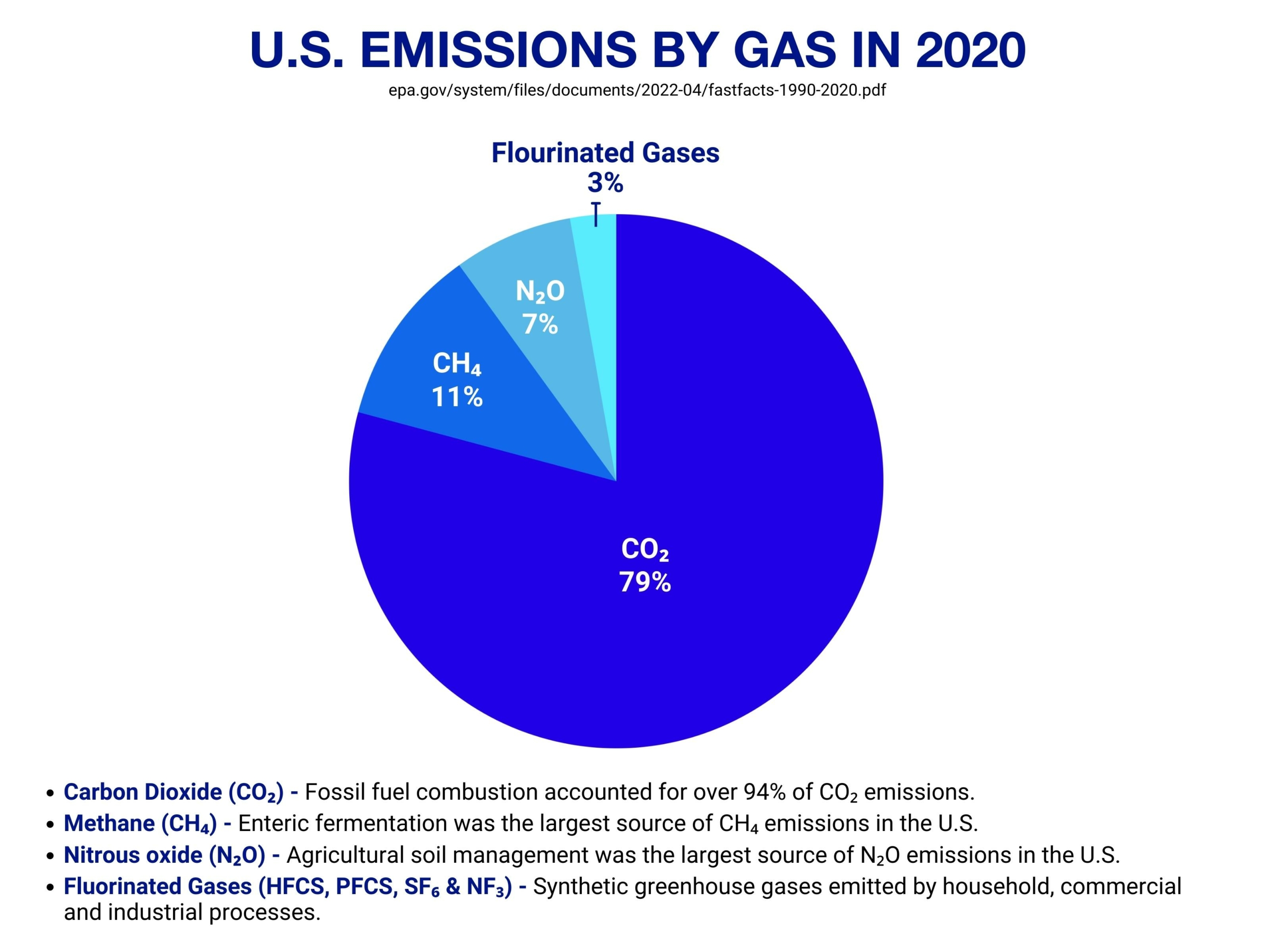
Although carbon dioxide is the most prevalent greenhouse gas, nitrous oxide and methane both absorb far more solar energy and warm the Earth significantly more than carbon dioxide. A ton of methane released into the atmosphere is roughly 30 times more potent at trapping heat than a ton of carbon dioxide, while a ton of nitrous oxide is almost 300 times more potent than a ton of carbon dioxide (US EPA, 2022a).
In the past 800,000 years, the Earth has naturally cycled through eight ice ages and warmer periods. The 20th Century spike in atmospheric carbon dioxide is an anomaly to that millennia-old trend and corresponds with human activity, most notably the industrial burning of coal and oil fossil fuels (NASA, no date).
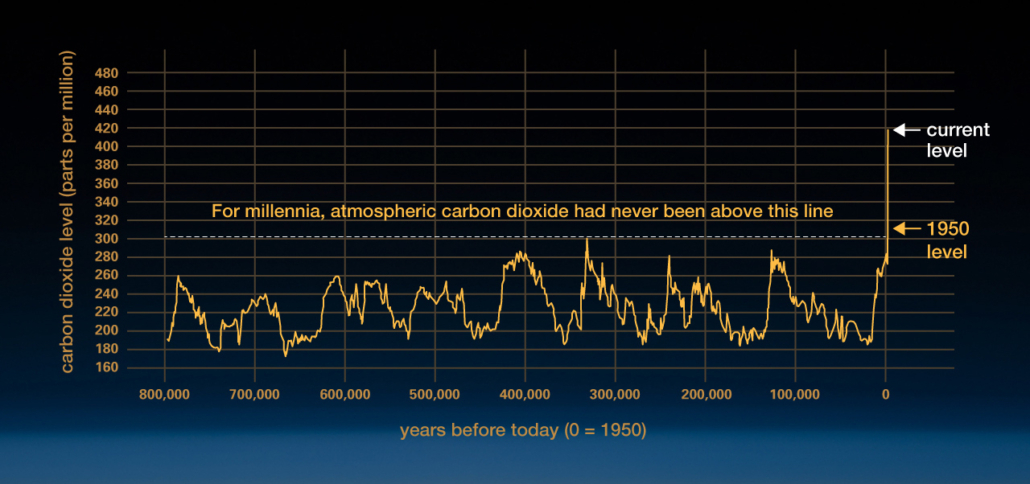
Source: climate.nasa.gov
Heat-trapping Blanket
The atmosphere is like a blanket that surrounds the Earth.
- When we burn fossil fuels for energy, carbon dioxide is emitted into the atmosphere.
- Carbon dioxide acts like a blanket that traps heat from the sun.
- The thicker the blanket, the more heat becomes trapped in the atmosphere.
- This warming disrupts the climate (FrameWorks Institute, no date).
Droughts, heavy rainfall, extreme heatwaves and wildfires are just a few of the changes observed in our climate. There is growing evidence that rising atmospheric and oceanic temperatures are rapidly de-stabilizing Earth’s systems, such as melting global ice cover, slowing ocean currents, and disrupting jet streams, which are all leading to accelerated climate chaos.
Growing Concern
Americans are becoming more worried about global warming, more engaged with the issue, and more supportive of climate solutions (Marlon et al., 2022).
In 2021, 33% of adult Americans were “Alarmed” by global warming (up from 18% in 2017) (Yale Program on Climate Change Communication.).
71% of Americans believe global warming will harm future generations, as well as plants and animals (Marlon et al., 2022).
The “Alarmed” segment strongly supports climate policies, but members of that segment do not know what they can do about the situation. In addition, the “Dismissive” segment of the population has trended downwards from 11% in 2017 to 9% in 2021 (Yale Program on Climate Change Communication). In all, every segment of the population has trended toward greater acknowledgement of the reality of human-caused climate change, and all are becoming more concerned about the impacts.
The Role of Agriculture
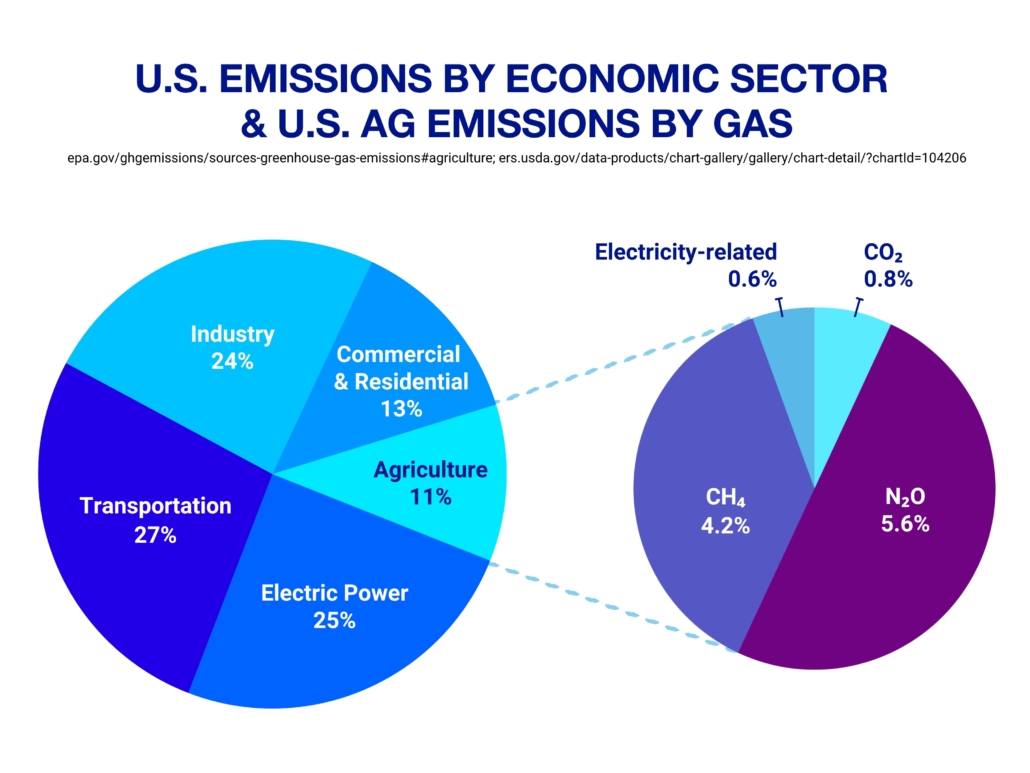
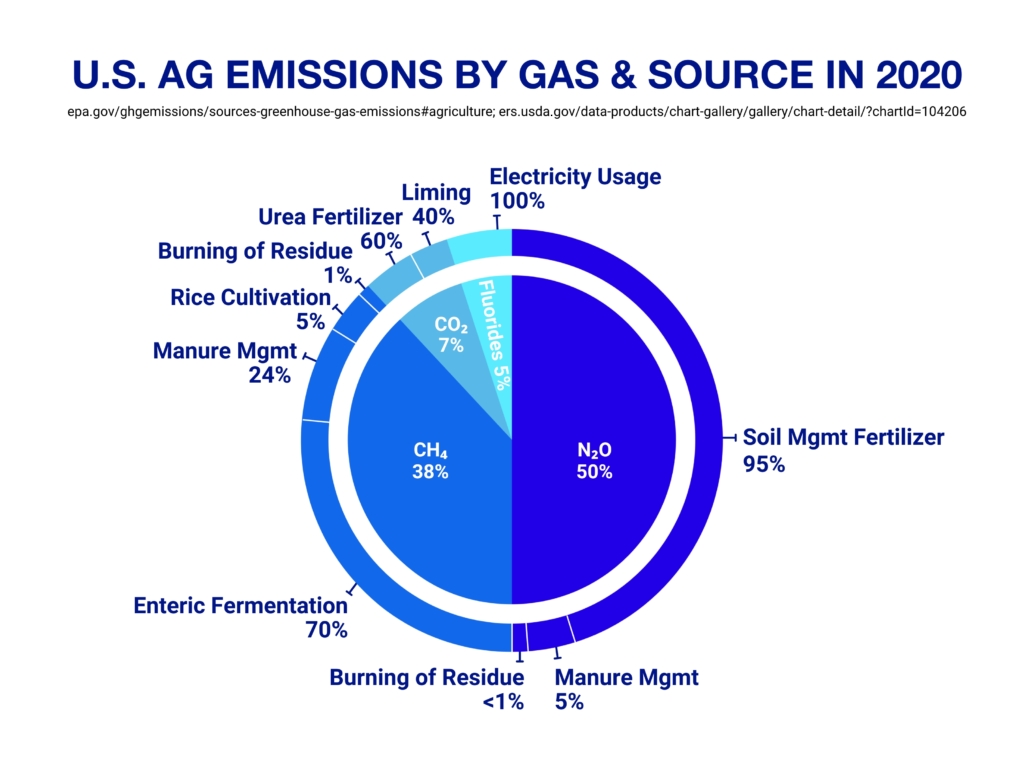
As of 2020, agricultural production accounted for 11% of total U.S. greenhouse-gas emissions and contributed to emissions in a variety of ways (US EPA, 2022b):
- Nitrous oxide. The main sources are synthetic fertilization and application of managed livestock manure and other organic materials (such as biosolids).
- Methane. The main sources are enteric fermentation in ruminant livestock, stored manure management, rice cultivation, and field burning of agricultural residues.
- Carbon Dioxide. The main sources are urea fertilization and liming, tillage, and soil disturbance leading to microbial oxidation and respiration of soil carbon (US EPA, 2022b).
The global food system, which includes not only production agriculture but combustion of fossil fuels in food production and supply chains, comprises roughly 30% of all global emissions. If we were to stop all other emissions immediately, food-systems emissions alone would soon push global warming beyond the 1.5°C Paris target (Clark et al., 2020).
“The goal of the Paris Agreement is to limit average global temperature increases above preindustrial levels to “well below 2°C” and to pursue efforts to “limit increase to 1.5°C.” Achieving either goal requires large and rapid reductions in greenhouse gas (GHG) emissions.” (Clark et al., 2020)
The Impacts are Extreme
It’s Bad
As of 2021, human-caused emissions of heat-trapping gases had warmed the climate by almost 2° F (1.1° C) above pre-industrial times. Scientists are discovering that with this temperature rise, climate change is accelerating more rapidly than originally thought: (NASA, no date (b))
Events such as megadroughts, extended wildfire seasons, and extreme rainfall happen more frequently and with greater intensity than predicted (NASA, no date (b)).
Some of the observed changes to our climate are irreversible over the next hundreds to thousands of years (NASA, no date (b)).
With every additional increment of global warming, changes in weather extremes continue to intensify. Every additional 0.5°C of global warming causes increased intensity and frequency of hot extremes— including heatwaves—and heavy precipitation, as well as agricultural and ecological droughts in some regions (IPCC, 2021).
There is a high level of confidence that global temperatures will rise by almost 3° F (1.5° C) in the next few decades (NASA, no date (b)). Increased temperatures cause greater moisture evaporation from Earth’s surface, resulting in more moisture being held in the atmosphere for rain and snow. Heavy precipitation events will intensify and become more frequent in most regions. On the global scale, extreme daily precipitation events are projected to intensify by about 7% for each 1°C of global warming (IPCC, 2021). Hurricane Ian in 2022 was another example of hurricane-related storm intensity becoming stronger and more frequent with a warming climate.
Impacts on Agriculture
Climate change is already causing severe disruption to agricultural systems in different regions across the United States, and these disruptions are expected to increase in magnitude, duration, and type (USGCRP, 2022). Examples include the following:
- Changing precipitation patterns, causing extreme drought in some regions and unpredictable flooding and hailstorms in other regions
- Diminishing supplies of surface and underground freshwater
- Increasing heatwaves and wildfires, more frost-free seasons, and longer growing seasons
- Stronger and more destructive winds
- New and greater pest pressures
Crop production impacts are variable, depending on crop seasonality and location: for example, 1.5°C of global warming risks reductions in corn yields and increases in wheat yields (Leippert et al., 2020).
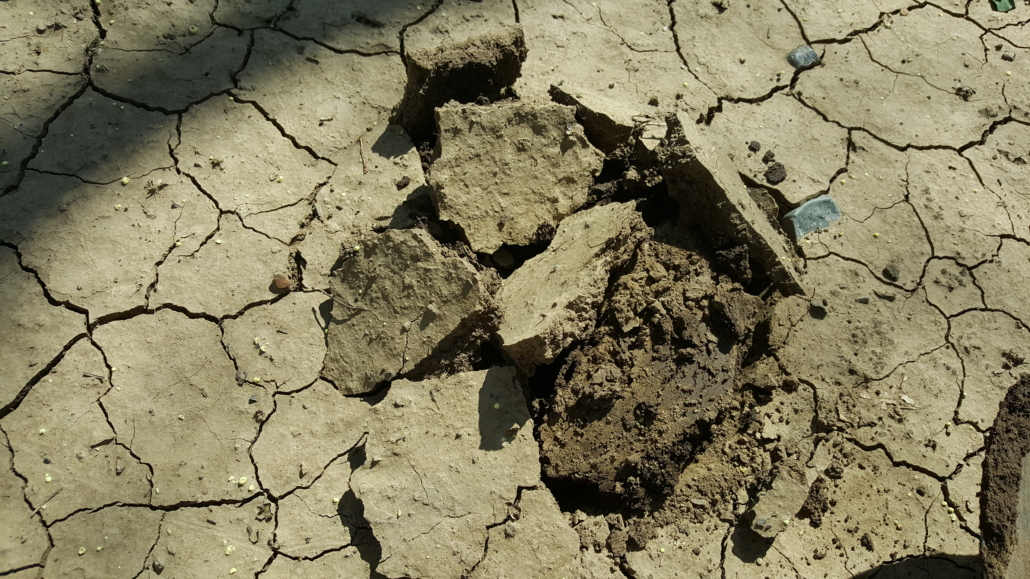
Surface crusting as a result of poor soil structure. The crust prevents water and air infiltration into the soil. Photo: Rex Dufour, NCAT

Drought soil. Photo: Emilie Ritter, NCAT
We Are the Solution
There’s Hope
Climate change is illuminating the ways in which human activity can work against Nature. At the same time, climate change is illuminating ways in which we can cultivate a healing and reciprocal relationship with the land, such as (but not limited to) the following:
- Conserving energy and developing renewable energy to ultimately end our dependence on fossil fuels
- Preserving forests and preventing the clearing of land
- Managing materials use, reducing waste, and diverting organics to compost/mulch
- Growing food using regenerative agricultural practices
The “One Health” concept, coined by the World Health Organization, definitively states that the health of soils, plants, animals, ecosystems, people, and the planet is one and indivisible. Our health and wellbeing are inextricably linked to how we care for the soil, plants, animals, and ecosystems.
Mitigation
Mitigation is the reduction of GHG levels in the atmosphere, both in terms of removing the harmful legacy load of carbon dioxide that human-activity has already emitted into the atmosphere and dramatically lowering future GHG emissions. The principal mitigation strategies are as follows:
- Emissions Reduction – lessening the amount of GHGs that we release into the atmosphere
- Sequestration – capturing and storing atmospheric carbon dioxide
Agricultural conservation practices can benefit the climate by capturing atmospheric carbon through photosynthesis and storing it in above-ground biomass or below-ground soil organic matter, as well as by lowering on-farm GHG emissions — most especially methane and nitrous oxide.
Carbon naturally enters the agroecosystems through photosynthesis and becomes incorporated into crop biomass, woody plants and, ultimately, the soil through root exudates, fungal hyphae, and decomposition of organic material (plant residue, animal and microbial waste) by microbial activity. Healthy soils are high in organic carbon as a result of carbon inputs exceeding carbon losses over time.

Enhanced rates of CO2 from the atmosphere into vegetation and soil can be achieved in agricultural systems through a variety of conservation practices, such as the following:
- Implementing agroforestry practices that establish trees, shrubs, and woody plantings
- Establishing permanent strips of vegetation such as field borders, conservation cover, vegetative barriers, filter strips, and grassed waterways
- Planting continuous and diverse cover through practices such as cover cropping, conservation crop rotations, and range planting
- Minimizing soil disturbance through reduced till and no-till residue management
Conservation practices that reduce emissions include, but are not limited to, the following:
- Reduced synthetic fertilizer use
- Prescribed grazing systems for ruminant livestock
- Manure management and distribution
Adaptation
Adaptation is a set of long-term strategies to adjust to or prevent the impacts of climate change. Integrated and diversified agricultural practices reduce vulnerability to climate change by building resilience into the system and providing ways for farmers and ranchers to adapt to changing realities (Leippert et al., 2020).
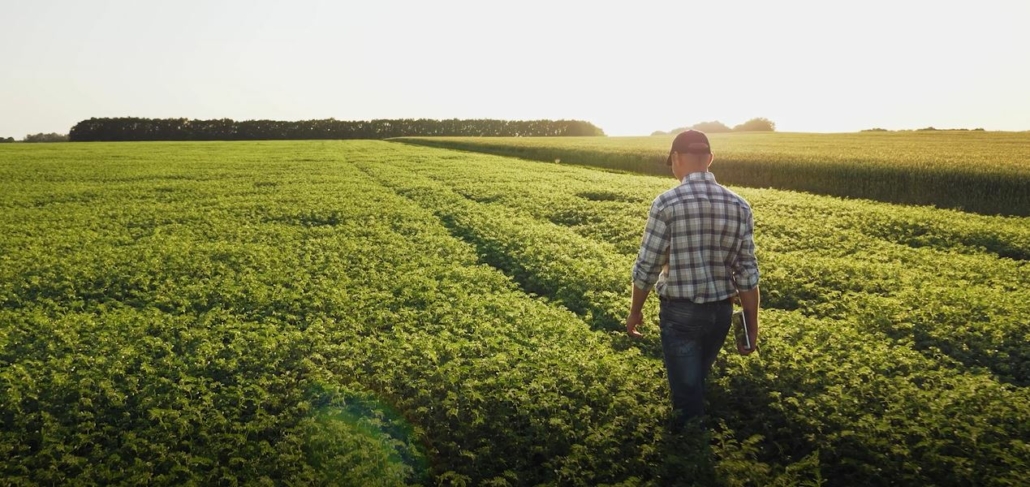
Farmer in the field. Photo: NCAT
Strategies that reduce the effects of climate change include, but are not limited to, the following:
- Improving soil health and soil water-holding capacity
- Protecting water quality
- Maintaining or restoring natural ecosystems and promoting biological diversity
- Diversifying crop or livestock species, varieties, or products (Janowiak et al., 2016)
- Reducing land clearing, deforestation, and production and use of fertilizers and other agrichemicals (Clark et al., 2020).
Notably, many conservation practices that mitigate climate change also build adaptive capacity on farms and ranches by building healthy, carbon rich soils, improving water infiltration and retention, preventing erosion, reducing groundwater contamination, promoting biodiversity, and establishing permanent woody plantings. Among the adaptation strategies at hand, biological diversification on farms consistently has strong positive climate change adaptation and mitigation impacts (Wiltshire and Beckage, 2022). Practices that foster increased biodiversity, as well as others, such as limiting soil disturbance, adding organic matter to the soil, and sequestering large quantities of carbon, are covered in detail in the next section of this series, Climate Beneficial Practices.
References
Clark, Michael A., Nina G. G. Domingo, Kimberly Colgan, Sumil K. Thakrar, David Tilman, John Lynch, Inês L. Azevedo, and Jason D. Hill. 2020. Global food system emissions could preclude achieving the 1.5° and 2°C climate change targets. Science. Vol. 370. p. 705–708.
FrameWorks Institute. No date. Heat-Trapping Blanket: A metaphor for the basic mechanism of climate change.
IPCC. 2021. Climate Change 2021: The Physical Science Basis. Contribution of Working Group I to the Sixth Assessment Report of the Intergovernmental Panel on Climate. Cambridge University Press, Cambridge, United Kingdom, and New York, NY.
Janowiak, Maria K., Daniel N. Dostie, Michael A. Wilson, Michael J. Kucera, R. Howard Skinner, Jerry L. Hatfield, David Hollinger, and Christopher W. Swanston. 2016. Adaptation Resources for Agriculture: Responding to Climate Variability and Change in the Midwest and Northeast. Technical Bulletin 1944. U.S. Department of Agriculture, Washington, DC.
Leippert, F., M. Darmaun, M. Bernoux, and M. Mpheshea. 2020. The potential of agroecology to build climate-resilient livelihoods and food systems. FAO and Biovision, Rome.
Marlon, Jennifer, Liz Neyens, Martial Jefferson, Peter Howe, Matto Mildenberger, and Anthony Leiserowitz. 2022. Yale Climate Opinion Maps 2021. Yale Program on Climate Change Communication.
NASA. No date (a). How Do We Know Climate Change Is Real?
NASA. No date (b). The Effects of Climate Change.
Shaftel, Holly (ed). 2018. The scientific method and climate change: How scientists know. NASA.
Shaftel, Holly (ed). 2022. Do scientists agree on climate change? NASA.
US EPA. 2022 a. Understanding Global Warming Potentials.
US EPA. 2022b. Sources of Greenhouse Gas Emissions.
USGCRP. 2022. The U.S. Global Change Research Program 2022–2031 Strategic Plan. U.S. Global Change Research Program, Washington, DC.
Wiltshire, S., and B. Beckage. 2022. Soil carbon sequestration through regenerative agriculture in the U.S. state of Vermont. PLOS Climate. Vol. 1, No. 4.
Yale Program on Climate Change Communication. No date. Global Warming’s Six Americas.

